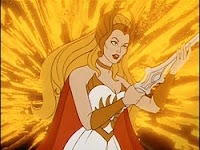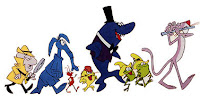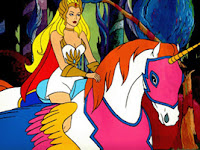We are in the end of the semester and the only thing we wish is to be on vacation. But now we are adults and vacation is not like in the time we were kids ; when we would spend lots of hours in front of TV, watch our favorite cartoons, play videogames and play a lot with our friends… Didn’t you feel something on your heart? A mix of nostalgia and joy or the wish to come back to past and to be a child again (for some moments of course)?
Almost everybody likes cartoons! With heroes, animals, people, robots…whatever, we always have a favorite one and these “animated creatures” mark our lives. Besides being funny or touching cartoons may approach themes of everyday life, politic, features of society etc.
Wile E. Coyote and Road Runner

 Created in 1948 for Warner Bros, Wile E. Coyote and Road Runner are characters of Looney Tunes but they star in a series of long-running series. Its creator said he created the Coyote-Road Runner cartoons as a parody of traditional "cat and mouse" cartoons such as Tom and Jerry. A desert is the scenery for the adventures. Coyote is always trying to catch Road Runner, but the latter is so smart and fast, then he never succeeds. It’s is interesting that in the beginning of each episode there is always a square with scientific names for the characters written in pseudo-Latin, such as: Velocitus Tremenjus and Road-Runnerus Digestus or Speedipus Rex and Famishus-Famishus. Even though Coyote is the “villain”, many people prefer this crazy and funny creature (I do too!). This is one of my favorite cartoons!
Created in 1948 for Warner Bros, Wile E. Coyote and Road Runner are characters of Looney Tunes but they star in a series of long-running series. Its creator said he created the Coyote-Road Runner cartoons as a parody of traditional "cat and mouse" cartoons such as Tom and Jerry. A desert is the scenery for the adventures. Coyote is always trying to catch Road Runner, but the latter is so smart and fast, then he never succeeds. It’s is interesting that in the beginning of each episode there is always a square with scientific names for the characters written in pseudo-Latin, such as: Velocitus Tremenjus and Road-Runnerus Digestus or Speedipus Rex and Famishus-Famishus. Even though Coyote is the “villain”, many people prefer this crazy and funny creature (I do too!). This is one of my favorite cartoons!Smurfs

 These cute blue creatures were created in 1958 as comics’ characters, only in the 80s they became animated cartoon. The Smurfs fulfill simple archetypes of everyday people: Lazy Smurf, Grouchy Smurf, Brainy Smurf, and so on. All smurfs, with the exception of Papa, Baby, Smurfette, Nanny and Grandpa, are said to be 100 years old. Some people say this cartoon is communist because everybody is “equal” in the village; some characters are said to possess features of communist thinkers such as Karl Marx (represented by Papa smurf) and Trotsky (represented by Brainy smurf). The villain Gargamel would represent the USA in its seek for power and wealth. That's interesting, isn’t it?
These cute blue creatures were created in 1958 as comics’ characters, only in the 80s they became animated cartoon. The Smurfs fulfill simple archetypes of everyday people: Lazy Smurf, Grouchy Smurf, Brainy Smurf, and so on. All smurfs, with the exception of Papa, Baby, Smurfette, Nanny and Grandpa, are said to be 100 years old. Some people say this cartoon is communist because everybody is “equal” in the village; some characters are said to possess features of communist thinkers such as Karl Marx (represented by Papa smurf) and Trotsky (represented by Brainy smurf). The villain Gargamel would represent the USA in its seek for power and wealth. That's interesting, isn’t it? Top Cat

 This funny cartoon created in 1961 was inspired by characters from the popular situation comedy You'll Never Get Rich (later called The Phil Silvers Show). It has also been said that the Bowery Boys influenced the show. A frequent plot-line revolved around the local policeman, Officer Charles "Charlie" Dibble, and his ineffective attempts to evict the gang from the alley. The only reason that he wanted to be rid of them was that Top Cat and his gang were constantly attempting to earn a quick dollar—usually through an illegal scam. Top cat and his gang lived in New York, but in the Brazilian dubbing, New York City was substituted for Brasília.
This funny cartoon created in 1961 was inspired by characters from the popular situation comedy You'll Never Get Rich (later called The Phil Silvers Show). It has also been said that the Bowery Boys influenced the show. A frequent plot-line revolved around the local policeman, Officer Charles "Charlie" Dibble, and his ineffective attempts to evict the gang from the alley. The only reason that he wanted to be rid of them was that Top Cat and his gang were constantly attempting to earn a quick dollar—usually through an illegal scam. Top cat and his gang lived in New York, but in the Brazilian dubbing, New York City was substituted for Brasília. She-ra
 She-Ra was intended to appeal to young girls in the same way that He-Man appealed to young boys. She-Ra is introduced in the animated movie The Secret of the Sword as Force Captain Adora (She-ra is the alter ego of Princess Adora and the twin sister of He-Man) an agent of the Evil Horde that rules the planet Etheria. She discovers that she is the long-lost sister of Prince Adam of Eternia, having been stolen by the Horde's leader, Hordak, as a baby. She is granted the Sword of Protection, which parallels He-Man's Sword of Power, gaining the power to transform into She-Ra, her secret identity.
She-Ra was intended to appeal to young girls in the same way that He-Man appealed to young boys. She-Ra is introduced in the animated movie The Secret of the Sword as Force Captain Adora (She-ra is the alter ego of Princess Adora and the twin sister of He-Man) an agent of the Evil Horde that rules the planet Etheria. She discovers that she is the long-lost sister of Prince Adam of Eternia, having been stolen by the Horde's leader, Hordak, as a baby. She is granted the Sword of Protection, which parallels He-Man's Sword of Power, gaining the power to transform into She-Ra, her secret identity. Bobby's World

 Who does not remember this little boy and his smooth voice that made mornings happier in the 90s?! Bobby’s world is an animated cartoon series about the daily life of Bobby Generic and his very overactive imagination on how he sees the world. Bobby’s family was also full of adventures. His mother wan an Elvis Presley fan, his sister was a boring teenager and his brother used to bother him. His uncle Ted was the only one who understood his imaginative mind (sometimes I’m just like Bobby)!!!! Bobby was created by the Canadian actor-comedian Howie Mandel who interacted with the boy in the beginning and in the end of each episode.
Who does not remember this little boy and his smooth voice that made mornings happier in the 90s?! Bobby’s world is an animated cartoon series about the daily life of Bobby Generic and his very overactive imagination on how he sees the world. Bobby’s family was also full of adventures. His mother wan an Elvis Presley fan, his sister was a boring teenager and his brother used to bother him. His uncle Ted was the only one who understood his imaginative mind (sometimes I’m just like Bobby)!!!! Bobby was created by the Canadian actor-comedian Howie Mandel who interacted with the boy in the beginning and in the end of each episode.Now guys, let me know:
- Do you like cartoons?
- What are you favorite ones?
- Do you like the ones shown here?
By KamilaSantana.




























